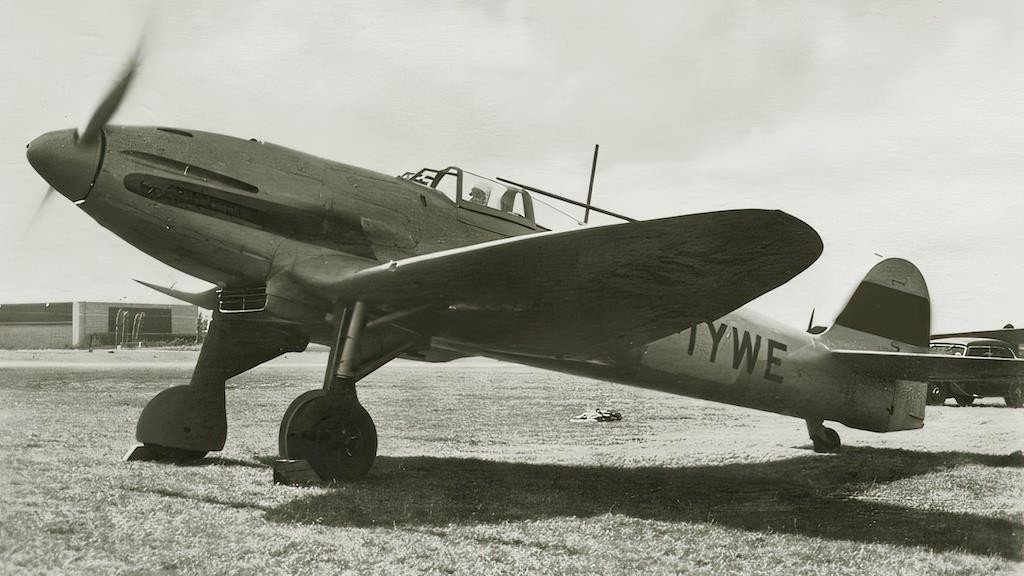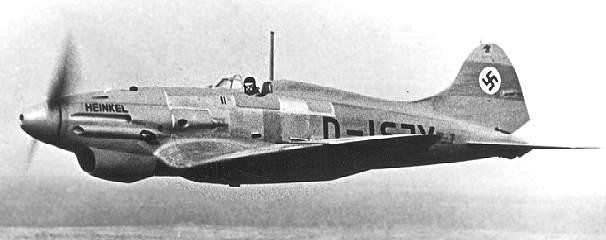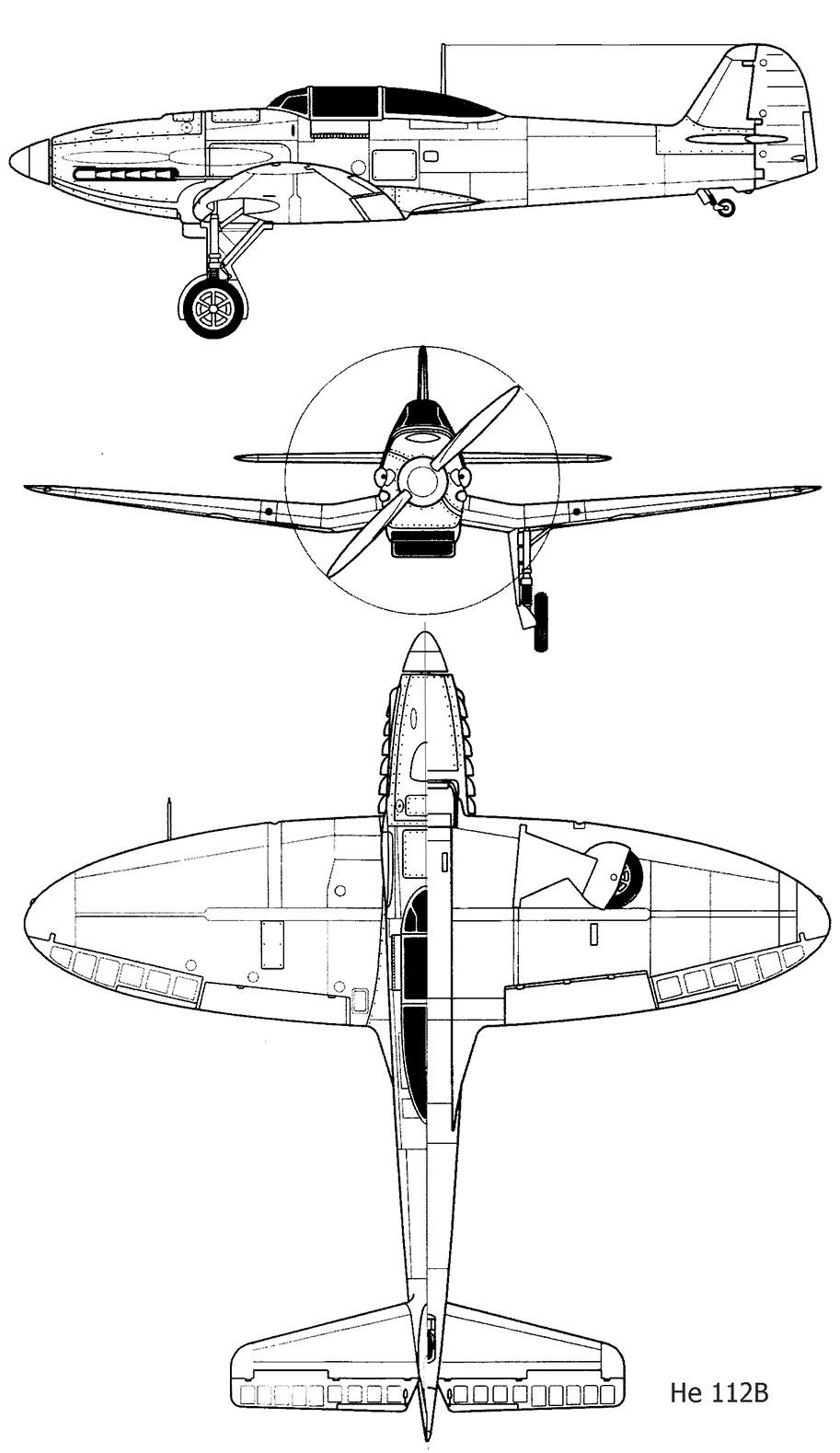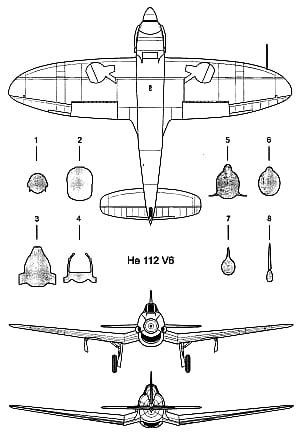| Type |
|
He 112 E Single seat fighter (= He 112 B) |
| Engine |
|
1 Junkers Jumo 210 Ea |
| Dimensions |
Length , height , span , wing area , |
Length 9,3 m, height 3,85 m , span 9,1 m , wing area 17,0 m2 , |
| Weights |
Empty , loaded , max. take off weight |
Empty 1620 kg, loaded 2250 kg , max. take off weight fuel 230 kg |
| Performance |
Max.. speed , cruising speed , range , endurance , service ceiling , climb |
Max.. speed 430 km/h at sea level , 485 km/h at 4000 m, cruising 425 km/h at 4000 mspeed , range 800 km, endurance , service ceiling 8500 m , climb to 2000 m 2,5 min., to 4000 m 6,0 min. |
| Armament |
|
2 7,9 mm MG 17 with 500 rounds each, 2 20 mm MG/FF cannons with 60 rounds each, 6 10 kg bombs |
The He 112 is an all-metal monoplane with an enclosed cockpit and retractable landing gear with a tailwheel. Designed at the Ernst Heinkel Flugzeugwerke Design Bureau under the leadership of Siegfried and Walter Gunther. The prototype aircraft made its maiden flight in September 1935. Serial production began in March 1938 at the Heinkel plant in Rostock.
The aerodynamic perfection of the He 112 was achieved by using a smooth working skin, a thin cantilever wing, retractable landing gear and an enclosed cockpit. The ellipsoidal wing had minimal inductive resistance, and the “reverse gull” scheme made it possible to reduce the height of the landing gear and helped to reduce the interference between the wing and the fuselage.
However, compared to its competitor Messerschmitt Bf 109, the Heinkel fighter turned out to be more complex and expensive. Messerschmitt created an extremely successful aircraft - light and obedient in piloting, fast and very stable. It surpassed the He 112 in maximum speed and acceleration characteristics, but the Heinkel proved to be more maneuverable due to the lower wing loading. It also had other advantages - better take-off and landing characteristics, better steering stability due to a wider chassis track, and good visibility. The Heinkel fighter did not have a gargrot behind the cockpit, the fuselage design of the Bf 109 did not allow the installation of a drop-shaped canopy. The climb rate of both machines was roughly the same.
However, during comparative tests, the Messerschmitt fighter turned out to be more successful. Two He 112 accidents had a fatal effect on the further fate of this machine.
He 112 V4 (another designation He 112 A0) was equipped with a forced Jumo 210 Da engine, the power of which could be increased for a short time, within five minutes, to 695 hp. In addition, the shape of the wing has changed again, with a more curved leading edge and rounded tips. There were no machine guns on the plane.
The V5 was similar to the V4 in everything, but only with weapons. In the spring of 1937, this aircraft was demonstrated to a Japanese naval delegation visiting Germany. The Japanese showed interest and in March 1937 the V5 was shipped by sea to Japan.
The next V6 model was instead of machine guns armed with a 20-mm automatic cannon "Rheinmetapl Borzig" MG C / 30L, located in the collapse of the cylinder blocks and firing through the hollow shaft of the propeller. The plane was born in July 1936. Soon, the German Ministry of Aviation decided to use the mutiny of General Franco that broke out in Spain and the subsequent Civil War as a testing ground for new combat aircraft and tactics of their use. In accordance with this decision, three prototypes Bf 109 and He 112 V6 went to Spain in November 1936.
The prototype He 112 V7 differed from its predecessors literally in everything: wing, fuselage, empennage, engine. The wingspan was reduced for the third time, so that it became even less than the length of the fuselage (a very bold and extraordinary decision for those years. No serial combat aircraft had such a short wing until the advent of jet aircraft). The shape of the keel and stabilizer has been completely changed. The rudder area has noticeably increased. The underside gargrot disappeared, and for the first time in world practice, the cabin itself was covered with a transparent teardrop-shaped lantern with an all-round view. The only thing that the designer remained faithful to was the oval shape of the wing and the “reverse gull” pattern. Moreover, on the V7, the wing outlines came close to the "clean" ellipse.
A new promising engine "Daimler-Benz" DB 600A with a capacity of 950 hp was installed on the plane, which made it possible to achieve high speeds. However, the same engines were on the He 111 bombers, the construction program of which was considered a priority. Heinkel was made unambiguously clear that he would not receive such "engines" for his fighters. As a result, willy-nilly, it was necessary to return to the low-power Jumo 210. True, another copy managed to fly with the Daimler-Benz - the V8, made according to the "old", that is, similar to the V4-V6 scheme.
An interesting page in the biography of No 112 was the participation of several of its prototypes in the rocket experiments of Professor Werner von Braun. In 1936, von Braun turned to Ernst Heinkel with a request to provide an aircraft for use as a flying bench for testing a prototype liquid-propellant rocket engine. The choice fell on the He 112 V3. At the beginning of the next year, the machine was equipped with a Walther liquid-propellant engine, tanks for fuel (methanol) and oxidizer (liquid oxygen). The piston motor remained. It was assumed that the aircraft would take off and land on it, and turn on the liquid-propellant engine only in the air.
The alteration did not take much time, and at the beginning of March, they decided to "drive" the rocket engine on the ground. On the first launch, it exploded. The wreckage of the plane was scattered several hundred meters. Fortunately, the test team, anticipating this turn of events, was in hiding.
Failure did not confuse the scientist, and he begged Heinkel for a second plane - Not 112 V8. After being equipped with a rocket engine, the letter U was added to the vehicle index. The installation of the liquid-propellant engine in the tail cone required the transfer of the crutch wheel one meter forward. The stabilizer was reinforced with additional struts.
Ground tests were successful. In April 1937, pilot Erich Warzitz at the Peenemünde test site for the first time raised a "rocket-piston" fighter into the air. Having reached an altitude of 800 meters, he turned off the Daimler-Benz and pressed the start button of the Walter. Later, the pilot admitted that he did it with bated breath. But there was no explosion. A three-meter tongue of flame escaped from the tail of the plane, and the car began to accelerate rapidly. In 13 seconds, the speed increased from 400 to 460 km / h. It was a success. The liquid-propellant engine has proved its right to exist. A few years later, another modification of the same engine lifted the famous Me 163 fighter into the air.
The flights of fighters with a combined power plant gave Heinkel and von Braun valuable information for creating an experimental He 176 rocket aircraft. And the eighth prototype He 112 was returned to its original appearance at the end of 1937. The rocket engine and all the equipment for its operation were dismantled, the tail wheel was installed in the same place. In the spring of the following year, the V8 was sent to Spain.
Not 112 V9 (another designation - Not 112 V-0) carried extremely powerful weapons for its time: two synchronous MG 17 machine guns with 500 rounds of ammunition per barrel and two 20-mm Oerlikon MGFF cannons in wing consoles with ammunition for 60 shells. Serial "Messerschmitts" Bf 109 B were then armed with only two machine guns. In addition to firepower, the new "Heinkel" surpassed the "Messerschmitt" in speed (40 km / h), climb rate and ceiling. And this is with the same engine! The aircraft, in contrast to the Bf 109, had excellent visibility and high steering stability inherited from previous modifications. True, the increase in wing loading led to some deterioration in maneuverability and takeoff and landing characteristics.
In terms of the aggregate tactical and technical data, the He 112 B-0 looked much better than the early modifications of the Messerschmitt in the role of an interceptor, that is, in the very role that the 1934 specification provided for. But he only appeared too late. By that time, the Bf 109 was mass-produced, and no one was going to break the well-oiled production cycle for the sake of a new machine. Moreover, "Messerschmitt", as already mentioned, turned out to be cheaper, more technologically advanced and simpler than He 112.
A total of 98 aircraft of all modifications were built, including 15 prototypes of the A-0 series.







